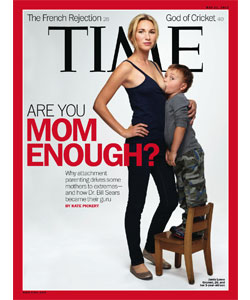When it comes to motherhood, everyone has an opinion on how it should be done. So it was no surprise when 26-year-old model Jamie Grumet caused a near-cosmic stir when she posed on the cover of Time Magazine, breastfeeding her nearly 4-year-old son.
Grumet’s approach to motherhood is attachment parenting, which is a concept developed by Dr. William Sears, 72, as outlined in his 1992 book, “The Baby Book.”
Sears, raised by a single mother himself, believes that moms should be in near constant contact with their child, wearing their baby if possible, letting them sleep in the same bed with them, and tending to their every want and need.
Of the many benefits of this practice, Sears argues that attachment parenting produces children who are physically, emotionally and psychologically healthy, stating that children who are a product of this kind of parenting rarely – and possibly even never – turn out to be bullies or have other developmental issues.
One of the other prongs of attachment parenting is breastfeeding until the mother – and child – feel the time is right to stop, which explains why Grumet still breastfeeds her almost 4-year-old son.
Grumet, who told The Today Show that she knew full well what she was getting into by posing so provocatively on the Time Magazine cover, says she was breast fed herself until she was six years old, and believes 100% in the concepts of attachment parenting.
But she hopes women who aren’t able to comply with all of the recommendations don’t feel judged or inadequate as mothers. Instead, she and Dr. Sears agree that the child-mother relationship is unique to each mother and baby, and that the mother ultimately has the right to decide what’s best for she and her child.
But moral issues and personal preference aside, there’s the fact that breast feeding is incredibly healthy for both mom and child. And not just in the case of nutrients for the developing baby, but also for the mother’s post-pregnancy weight loss as well.
According to DietsInReview.com’s Registered Dietitian, Mary Hartley, RD, “In order to produce about 25 ounces of milk a day, it costs the nursing mother about 650 calories above her usual requirements. To meet this need, the Institute of Medicine recommends eating 500 extra calories a day. The remaining 150 calories are drawn from fat stores accumulated during pregnancy.
Mary says it’s important that the calories come from nutritious foods, especially ones that are high in protein and iron, such as meat, fish, poultry, beans and legumes. These foods should ideally also be high in calcium, like milk, cheese, fortified cereals, and green leafy vegetables. “Without restricting their calorie intake,” says Mary, “breastfeeding mothers usually lose 1 to 4 pounds per month.”
But how long is too long when it comes to breastfeeding? Mary says the American Academy of Pediatrics (AAP) recommends breastfeeding for the baby’s first year. “From birth until about six months, breast milk is the sole source of nutrition. At six months, solid food is added but breastfeeding continues to make a significant nutritional contribution until at least 12 months. Once the child is eating a wide variety of solid foods, breast milk becomes less critical from a nutritional perspective, but continues to provide comfort and security to the child. Beyond the first year, the AAP advises mothers to continue nursing for as long as mutually desired by mother and child.”
Ultimately, the length of the nursing relationship is a personal choice, and AAP advises nursing mothers to follow their instincts. So mothers should simply do what they feel is best for them and the baby.
Also Read:
January Jones Adds Placenta to Her Diet
